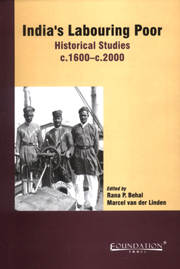Book contents
- Frontmatter
- Contents
- Notes on Contributors
- Frontispiece
- Preface
- Introduction
- Working Across the Seas: Indian Maritime Labourers in India, Britain, and in Between, 1600–1857
- The Brickmakers' Strikes on the Ganges Canal in 1848–1849
- On the Move: Circulating Labour in Pre-Colonial, Colonial, and Post-Colonial India
- Mobility and Containment: The Voyages of South Asian Seamen, c. 1900–1960
- Power Structure, Discipline and Labour in Assam Tea Plantations during Colonial Rule
- “Following Custom”? Representations of Community among Indian Immigrant Labour in the West Indies, 1880–1920
- Masculinity, Respect, and the Tragic: Themes of Proletarian Humor in Contemporary Industrial Delhi
- Stretching Labour Historiography: Pointers from South Asia
- DOCUMENT
- Select Bibliography
On the Move: Circulating Labour in Pre-Colonial, Colonial, and Post-Colonial India
Published online by Cambridge University Press: 05 January 2012
- Frontmatter
- Contents
- Notes on Contributors
- Frontispiece
- Preface
- Introduction
- Working Across the Seas: Indian Maritime Labourers in India, Britain, and in Between, 1600–1857
- The Brickmakers' Strikes on the Ganges Canal in 1848–1849
- On the Move: Circulating Labour in Pre-Colonial, Colonial, and Post-Colonial India
- Mobility and Containment: The Voyages of South Asian Seamen, c. 1900–1960
- Power Structure, Discipline and Labour in Assam Tea Plantations during Colonial Rule
- “Following Custom”? Representations of Community among Indian Immigrant Labour in the West Indies, 1880–1920
- Masculinity, Respect, and the Tragic: Themes of Proletarian Humor in Contemporary Industrial Delhi
- Stretching Labour Historiography: Pointers from South Asia
- DOCUMENT
- Select Bibliography
Summary
In 1770 a British official in Madras observed groups composed of men, women, and children who formed “a kind of travelling community of their own under a species of Government peculiar to themselves, with laws and customs which they follow and observe wherever they go”. These itinerant, coveted groups of earth and stone workers – “even courted by Princes” – circulated from worksite to worksite where they dug tanks (small reservoirs), ditches, and wells, and built roads and fortifications. They lived close to their worksites in “temporary hutts which they throw up for the occasion, and always chuse a spot distinct from any village, wandering from one place to another as is most convenient”.
Circulating labor (a phrase that captures frequent movement better than migrant labor), with a particular but not singular emphasis on construction labor, provides the subject matter of this paper. The paper seeks, spatially, to identify the substantial, pan-Indian presence of circulating workers; temporally, to establish the presence of many such workers in the pre-colonial, early colonial (e.g. 1770 Madras), high colonial (later nineteenth/early twentieth century) and post-colonial periods; and conceptually, to explore how we might situate these workers within the history of India.
CONCEPTUAL CONSIDERATIONS
A pioneering study of migrant labor in Europe, 1600–1900, stated that “little serious attention” had been paid to migrant workers despite their importance to European labor markets.
- Type
- Chapter
- Information
- India's Labouring PoorHistorical Studies, 1600-2000, pp. 85 - 110Publisher: Foundation BooksPrint publication year: 2007
- 2
- Cited by



